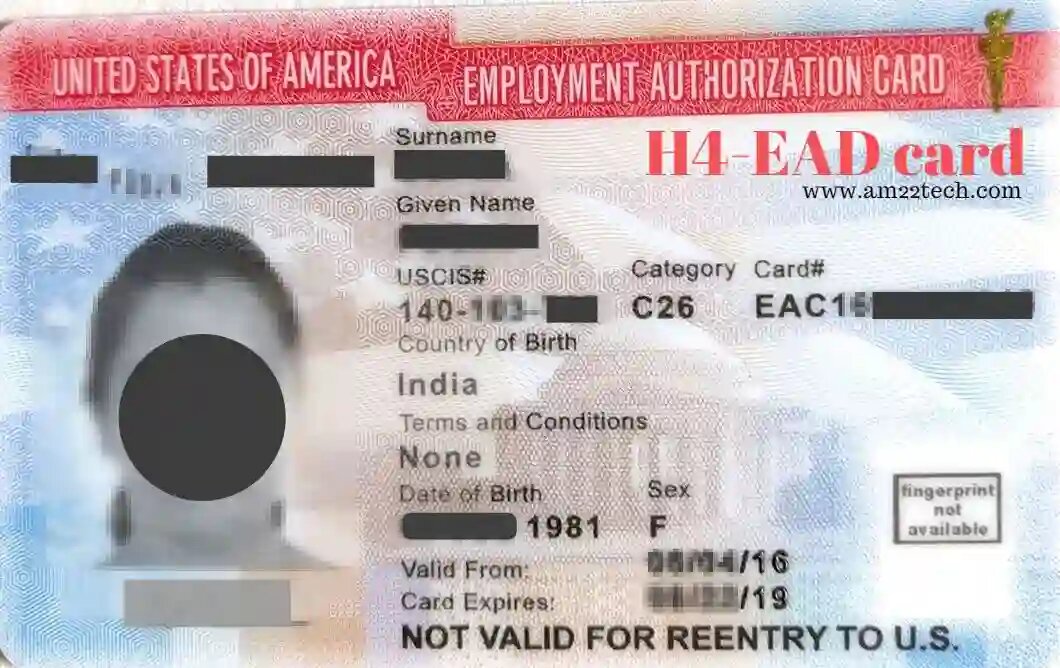Visa
H4 EAD Program: Complete Guide To Obtaining An H4 EAD Visa

The H4 EAD visa/card is only available if your spouse or parent is on an H-1B visa. Otherwise, you are not permitted to work with an H4 visa if your spouse or parent has another form of H visa, such as an H-1B1, H-2A, H-2B, or H-3 visa.
The EAD program has several benefits. Those with an approved EAD enjoy the following benefits:
- There is no cap for the EAD, so any spouse of H-1B visa holders can apply and be granted the EAD if they fulfill the requirements.
- With an EAD you do not need to have a Labor Condition Application (LCA), petition or sponsorship (Form I-129) from US government agencies.
- The EAD allows you to work in any sector of the economy in any type of legal job, so you are not only constrained to jobs which require extraordinary ability.
- You can renew the EAD as many times as you need as long as your spouse maintains an H-1B visa status and files for lawful permanent immigration.
- Those applying for an EAD do not need an active employment offer, but can seek for a job after they get the authorization.
- If you have an EAD, you are allowed to start your own business within the US and employ people.
Understand the Employment Authorization Document (EAD) better
Do I qualify for the H4 EAD Program?
Not all H-4 visa holders who are dependents of H-1B visa holders are eligible to apply for an EAD. There are two conditions, and H-4 dependents must meet at least one of them in order to apply for an H-4 EAD. The requirements are as follows:
- The H-1B visa holder must have an approved Form I-140, Immigrant Petition for Alien Worker, or be in the process of getting this form approved
- The H-1B visa holder must have a status approved under sections 106(a) and (b) of the American Competitiveness in the 21st Century Act of 2000. This act is amended by the 21st Century Department of Justice Appropriations Authorization Act (AC21). This act (AC21) allows H-1B visa holders to stay in the US beyond the six year limit if they are seeking lawful permanent residence (Employment Based Green Card).
H-1B employees with AC21 status must have their company file the PERM Labor Certification and Form I-140 at least 365 days before the 6 year cap. After this, H-4 visa holders can apply for EADs.
If the I-140 is denied, the H-4 visa holder cannot apply for an EAD. If the H-1B spouse’s I-140 status is canceled, so is the H-4 visa holder’s EAD.
H-4 holders cannot apply for EADs unless they meet one of these qualifications. USCIS will reject their application for non-eligibility.
How to get a H4 EAD to work in USA?
To obtain the authorization, applicants must go through a specific H-4 EAD process. This entails submitting various H-4 EAD documents as well as paying H-4 EAD costs. Before you begin the application process for the EAD, make certain that you are eligible for it. If you are eligible, you can begin the process of obtaining your EAD.
Submit the necessary documents
These documents are necessary to file for the EAD:
- Form I-765, Application for Employment Authorization
- Receipt that you have paid the application fees. The fee for applying for an EAD is $410. The payment needs to be made through a cashier’s check directed to USCIS. Unfortunately, there is no option to complete the payments online.
- Copy of your most recent Form I-94 that shows you are in the US with an H-4 visa.
- Form I-797 and Form I-539 which prove your stay in the US has been extended.
- 2 identical photographs which have Form I-94 number printed on the back with a pencil.
- Proof of your relationship with the H-1B visa holder through submitting a copy of your marriage certificate.
- A copy of the H-1B visa holder’s Form I-140 (or the approval notice if it has not been approved yet).
- Copies of the H-1B visa holder’s Form I-129, Form I-797, and current and prior Forms I-94.
- Copies of the H-1B visa holder’s current and old passports.
- Proof that Form I-140 or the PERM certification was filed for the H-1B visa holder at least 365 days before their visa reached the 6 year limit. This could be done by submitting copies of correspondence with the Department of Labor.
- If you want to receive electronic notifications of when your application has been accepted by USCIS, also submit Form G-1145, E-notification or Application/Petition Acceptance. This form should be attached to the first page of your application.
EAD Renewal
If you have had an EAD before and are only renewing it, you should also submit one of these additional documents:
- Copy of your previous EAD
- Your passport, which contains your name, last name, and a picture
- Your birth certificate with a photograph
- Your national documents with a photograph or fingerprints
- A foreign country visa
There are EAD applicants which lack one or more of these documents. In that case, you should be aware that you must file documents which qualify as secondary evidence. Secondary evidence includes:
- Receipt number of Form I-129 of the H-1B visa holder when they requested an extension of stay
- Receipt number of the approved Form I-140 of the H-1B visa holder
Foreign H-4 EAD applicants may have documents in their original language. USCIS and other US agencies do not accept documents in languages other than English.
Send such documents to a competent translator for English translation. US agencies should also notarize translated documents to verify their authenticity.
If USCIS grants you the EAD and Form I-766, you can work. No Form I-766, no job.
How long is the H-4 EAD Processing Time?
H-4 EAD processing times vary. If your H-1B spouse already has an authorized Form I-140, processing is faster. USCIS will request further paperwork if the H-1B spouse is on AC21 status, which may delay the procedure.
When you apply for an H-4 EAD, it usually takes three months or 90 days to hear back. All H-4 EAD applications are handled at the same speed because premium processing is not available.
Traveling outside the US while your H-4 EAD application is processed is not advised. USCIS may request more information or documents. If you’re abroad, responding to these inquiries will delay your EAD or potentially cause USCIS to deny it.
What kind of H-4 EAD jobs am I allowed to find?
EAD applications do not require a work offer. If you have one before applying, great, but if not, no worries. You can apply for jobs after acquiring the EAD.
You can work any job. If you file taxes and work legally in the US, you can work in any industry. You don’t need labor certifications or petitions either. Work full- or part-time without penalty.
If you want your EAD but don’t want to work, that won’t affect your H-4 status. EAD holders may not work. You can start working instantly whenever you wish.
Can I Get an EAD (Employment Authorization Document) Automatic Extension?
You qualify for an EAD automatic extension for up to 180 days if you meet the following criteria:
- You had correctly filled out the renewal form I-765 before your current EAD expired.
- Your renewal application belongs to a category eligible for an automatic extension.
- Your EAD category is the same as the “Class Requested” filled out on your form I-797C Notice of Action.
Here are the eligible categories for an automatic extension of your EAD as specified by the US government:
- Refugee
- Asylee
- N-8 (Parents of special immigrant children who are not yet 21).
- N-9 (Children— under 21— of immigrant parents or those who possess an N-9 visa).
- Nationals of Palau, Marshall Islands, or Micronesia.
- A person who was granted withholding of deportation.
- A person who holds temporary protected status (TPS).
- The spouse of a valid E nonimmigrant visa holder.
- The spouse of a valid L-1 nonimmigrant visa holder has L-2 immigrant status.
- A person whose application for asylum is pending.
- A person whose status of adjustment is pending.
- A person who has applied for cancellation of removal.
- Creation of Record (Adjustment Based on Continuous Residence Since January 1, 1972)
- A person whose application for TPS is pending.
- Section 210 Legalization (pending I-700).
- Section 245A Legalization (pending I-687).
- LIFE Legalization (application of adjustment to permanent residence).
- The spouse of an H-1B valid visa holder.
- VAWA self-petitioners (Violence Against Women Act)




















